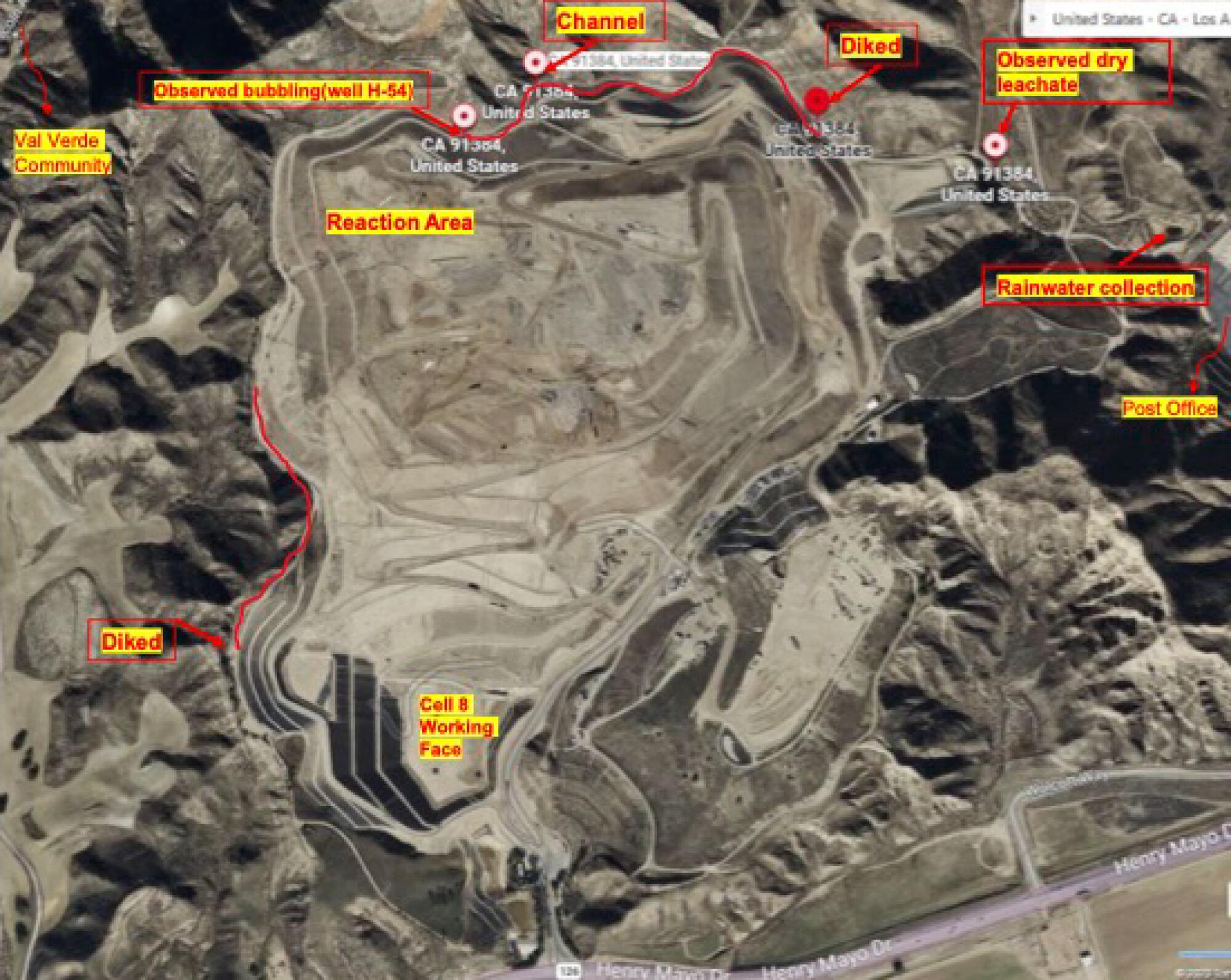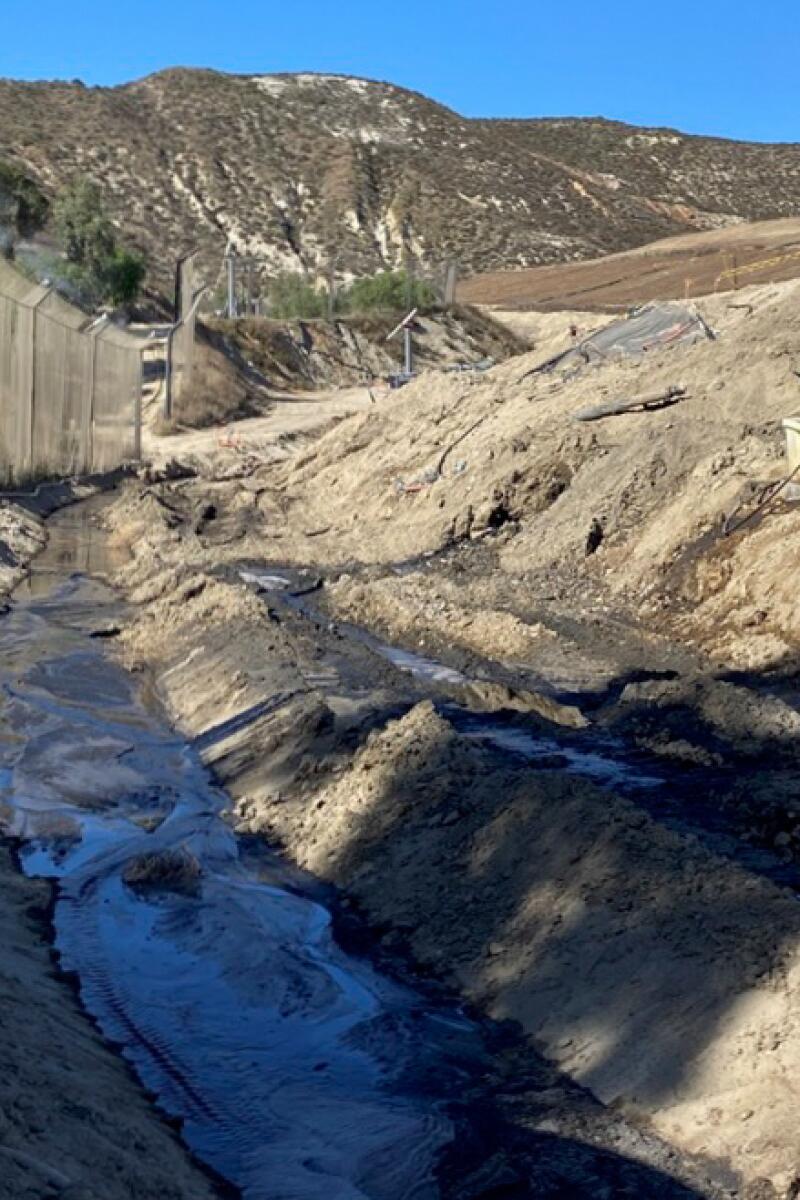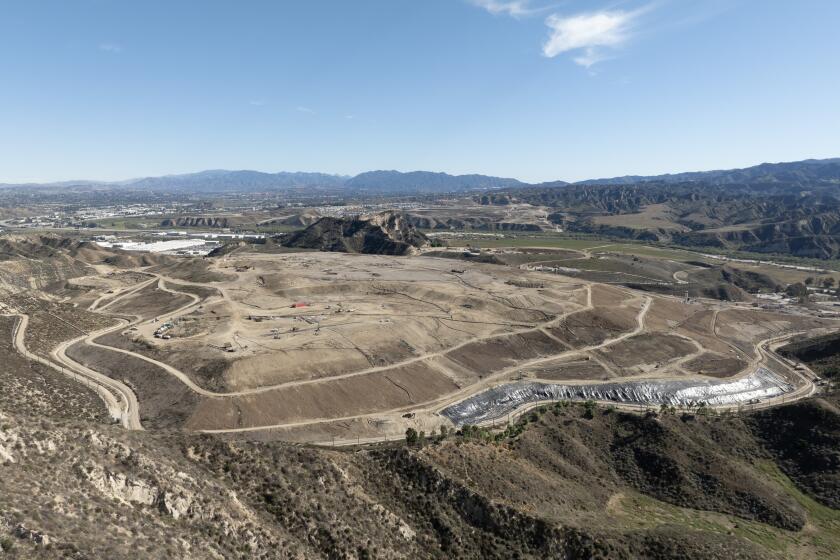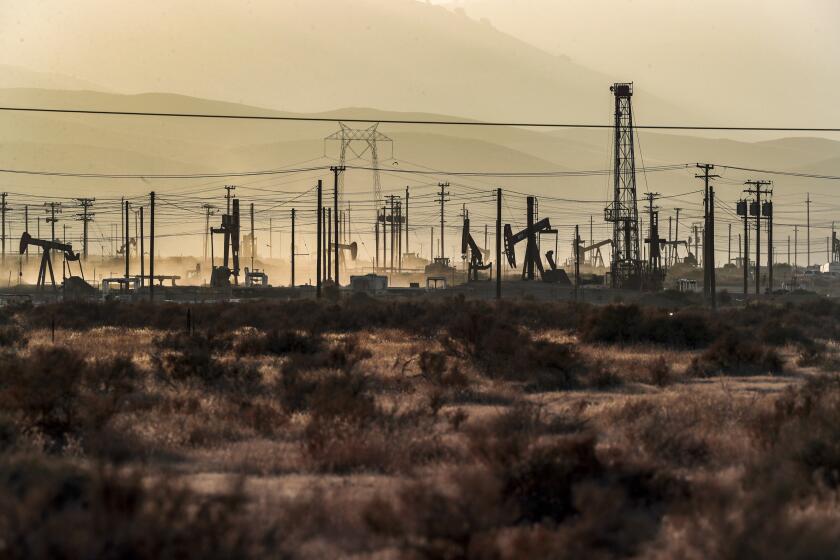As garbage smolders deep underground in Chiquita Canyon Landfill, polluted water bursts onto the surface due to extreme heat and intense pressure. (South Coast Air Quality Monitoring District)
- Share via
Vapor hisses from surface fissures. Bubbling ponds of effluent form “rivers of odorous waste.” And at times, steaming hot liquid bursts into the air like a geyser.
As operators struggle to contain a smoldering fire and pressure buildup deep within Chiquita Canyon Landfill, air quality regulators are raising alarms over the potential health risks posed by the toxic fumes escaping the Castaic facility.
Environmental regulators say that the local air and water samples have contained elevated levels of benzene, a cancer-causing chemical that evaporates easily. They also have reprimanded Waste Connections, the landfill’s owner, for failing to report the leaks when they first occurred and for not providing area residents with air quality data.
“The landfill operator is already collecting much of this air pollution information, but it isn’t being released to the community in a way that lets residents make informed choices to protect their own health,” said Jeff Lindberg of the California Air Resources Board.
Unusual chemical reactions at L.A. County’s two largest landfills raise serious questions about the region’s long-standing approach to waste disposal.
The gas and water leaks are being driven by a rare chemical reaction that has generated scorching heat and intense pressure within a 35-acre portion of the landfill. South Coast Air Quality Management District officials have described the conditions as almost volcanic and, in recent months, a white vapor has been observed hissing through long cracks in the face of the reaction zone.
The crisis has renewed calls to shut down the facility and prompted the U.S. Environmental Protection Agency to step in and oversee efforts to contain the growing problem. It was also the center of discussion during two days of testimony and public comments at a recent air district meeting.
During those discussions, air quality regulators argued that the landfill’s efforts to remove leaking wastewater were inadequate and noted that the landfill had no plans to dispose of the foul water on Sundays or some holidays. The agency also said that the landfill’s quarterly air monitoring reports failed to provide the public with real-time information for locals to protect themselves.

“We now know that this …[leakage] is a significant factor in contributing odors, especially in the Val Verde area,” said Larry Israel, an air district inspector. “These residents are complaining nonstop, 24 hours a day about odors, and our thinking is we need to stop this as soon as possible. They are being heavily impacted.”
For their part, Chiquita Canyon operators told regulators that they were committed to solving the problem.
“Everyone in this room wants the same thing: to slow and stop this reaction and reduce the impacts to the community,” said Megan Morgan, an attorney representing the landfill. “Chiquita may not experience this issue in the same way that its neighbors do, but Chiquita and its employees are there on-site each day working hard as they can to address this issue.”
Chiquita Canyon staff have constructed wells to extract liquids and gases that are fueling the smoldering conditions. They have installed a flare to burn off flammable gases, including methane, which has been detected at explosive levels at the landfill’s perimeter. They’ve also added soil to repair cracks where gases and liquids have been seeping out, operators said.
According to the regional water board, Chiquita Canyon has been disposing of around 2- to 4-million gallons of contaminated water a month for much of the past year. That water was made up of a combination of hazardous spills and the landfill’s efforts to proactively extract wastewater to relieve pent-up pressure, according to the Los Angeles Regional Water Board.


1. Contaminated water has seeped out of Chiquita Canyon Landfill in Castaic, forming streams of odorous waste and fumes. 2. The polluted water oozing out of Chiquita Canyon contains cancer-causing benzene and other chemicals, which environmental regulators fear is vaporizing and drifting into nearby communities.
So far, the wastewater has not migrated offsite, where it could pose a threat to local groundwater or streams. However, the spills began to grow larger last fall, when a concrete-lined stormwater channel at the perimeter of the landfill managed to capture the waste, officials said.
The main canyon, where garbage is burning, has a bottom liner that serves as an impermeable barrier to ensure water pollution doesn’t filter deeper underground into local aquifers. Although some worry the liner could have been damaged, there’s no evidence it has been compromised, officials said.
The U.S. EPA is now the lead agency tasked with containing a fire burning deep inside Chiquita Canyon landfill.
Steaming-hot, contaminated water has also surged to the surface, oozing out of fissures. These hazardous spills have formed bubbling ponds and “ultimately rivers of odorous waste,” according to officials with the SCAQMD. At times, this polluted water has erupted with such force that it has shot into the air “like a geyser.”
Air district officials reprimanded Waste Connections for failing to immediately report these incidents. Although Chiquita Canyon representatives recently acknowledged these hazardous spills have been occurring since mid-2022, they did not inform the air district that wastewater was spilling onto the surface until October.
Following testimony on the issue, the air district’s hearing board approved a litany of requirements intended to address the polluted water and nauseating fumes.
Among other requirements, Chiquita must now remove wastewater seven days a week and must provide real-time air quality data from two of its community monitoring stations, one in Val Verde and another in Hasley Canyon Park in Castaic.
The air district noted the wastewater from spills and gas samples contained elevated levels of benzene. On Oct. 7, the landfill’s community air monitoring at Hasley Canyon Park detected benzene at 69.5 parts per billion, more than eight times the state health limit for short-term exposure.
The landfill obtained these results in early November, but its representatives didn’t inform the air district until weeks after, according to Stephen Dutz, an air quality chemist with the district.
The U.S. Environmental Protection Agency is considering approval of California’s first ever carbon storage project, to be in Kern County.
The new requirements followed remarks from several people who live near the landfill — including Sarah Olaguez, whose home is due north of the facility.
“The board and the lawyers get to go home and put this down,” Olaguez told officials. “We go home and breathe it in while we sleep. We need real action. We need to be moved away from this landfill. We need to breathe clean air.”
Abigail DeSesa, who has lived in the area for about 25 years, said the persistent odors have trapped her indoors. She said she has stopped gardening in her yard, hiking local canyon trails and even hosting her grandchildren.
“We are living like we are in prison. ... Our quality of life is gone. My health is gone. And I feel hopeless,” she said.












